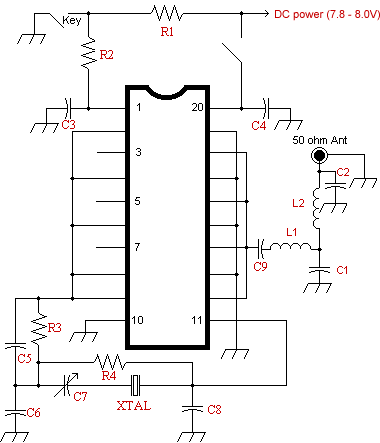
N7KSB used this transmitter, with a roof-mounted ground-plane antenna to work all continents and over 30 countries.
N7KSB's experimental 1/2 watt CW transmitter uses a 74HC240 high-speed CMOS octal buffer, one section which serves as a crystal oscillator, four sections of which amplify this signal, and three sections of which are unused. Because the 74HC240 dissipates 1/2 watt on 20M and 0.9 watts on 10M, it must be heat-sunk. Epoxying the IC to the ground plane in dead-bug of ugly construction provides adequate cooling. L1, a low-inductance coil, is sensitive to lead length, so if you build this transmitter with plug-in filters (Lew Smith uses phono plugs and jacks for this purpose), you may need to remove one or two turns from L1 to compensate for the extra lead length involved in wiring the coil plugs and socket.
The newer 74HC240's available today show little power drop-off on 10M, while older ones exhibited a 20% power drop-off. The older 74HC240's can handle power up to 10V, the newer ones latch up at 9V. It is therefore important to operate the rig at a supply voltage of 7.8 to 8 volts, which is a compromise between maximum power and safety.
The logic chips have built-in input and output buffers. The extra gain provided by the extra stage make it harder to get rid of key clicks. The rig's key-click filter therefore uses an unusually large time constant (33 ms.)
The output stages in 74HCxxx devices are designed to have equal pull-up and pull-down transistors. This minimizes even-order harmonics, simplifying the rig's output filtering.
The 74HC240 can directly drive a power MOSFET amplifier.
Construction Details:


C1 and C2 are mica or ceramic.
L1 and L2 are air-wound from #14 wire, with an inner diameter of
3/8 inch.
R1 22K ohms
R2 330K ohms
R3 470 ohms
R4 47K ohms
C3 0.1 mf
C4 0.1 mf
C5 22 pf
C6 47 pf
C7 20 pf Variable
C8 47 pf
C9 0.1 mf